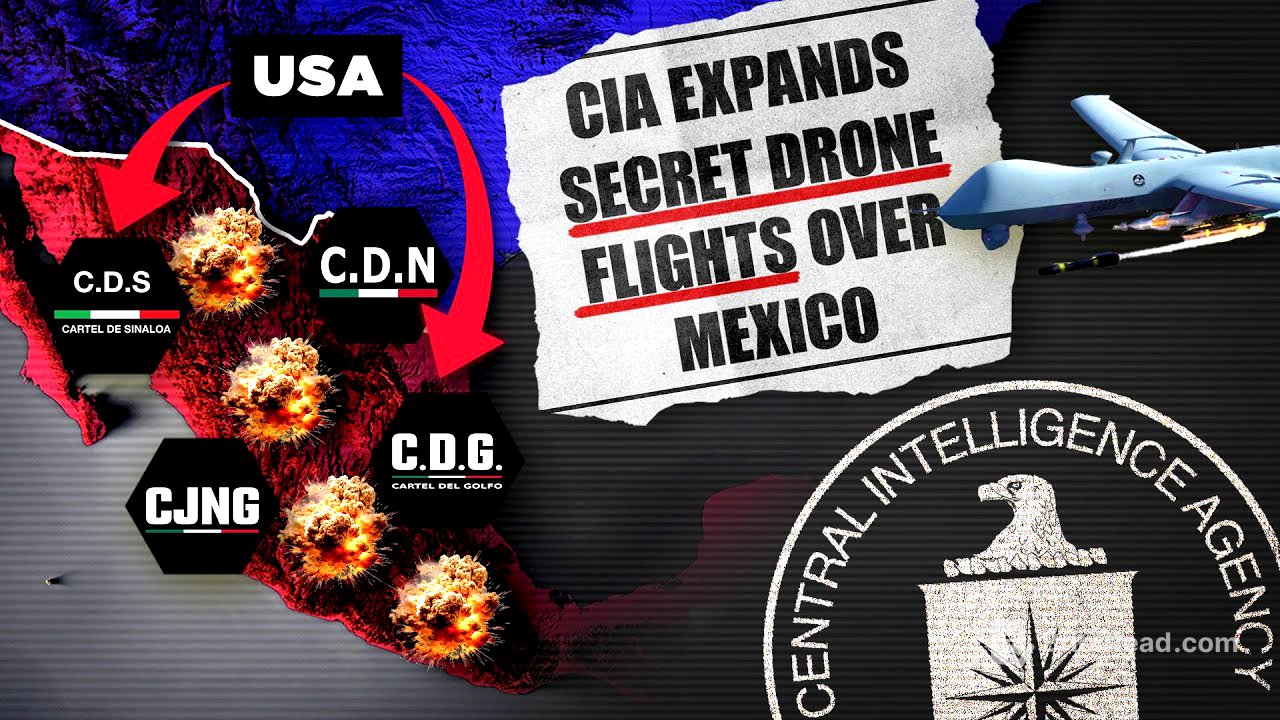TLDR;
The video discusses the escalating conflict between the US and Mexican cartels, focusing on the potential for US military intervention. It highlights the complexities of the drug war, the flow of drugs and weapons across the border, and the historical context of US-Mexico relations. The video also touches on the debate within the US government regarding how aggressively to confront the cartels, the potential consequences of military action, and the need for a multifaceted approach to address the root causes of the conflict.
- The US is considering military action against Mexican cartels due to the fentanyl crisis.
- Trump administration designated six Mexican cartels as foreign terrorist organizations.
- There are legal and geopolitical obstacles to US military intervention in Mexico.
- The cartels are well-equipped and control significant territory in Mexico.
- A multifaceted approach is needed to address the root causes of the conflict.
Introduction: The Escalating Conflict Between the US and Mexican Cartels [0:00]
The video begins by highlighting the ongoing violent conflict in Mexico between various cartels vying for power and control of drug trade routes. This conflict has resulted in approximately 400,000 deaths since 2006. The fentanyl and methamphetamine smuggled by these cartels have fueled the US opioid epidemic, causing over 250,000 overdose deaths since 2018. The possibility of US military intervention against the cartels in Mexico, once considered a fringe idea, has become increasingly plausible, especially with Donald Trump back in office.
Trump's Stance and Initial Actions Against Cartels [1:21]
The video details Trump's alleged consideration of military action against cartel-run drug labs in Mexico, including a plan to deny US responsibility for such attacks. Despite Trump's denial of these specific allegations, his rhetoric and that of other Republicans have intensified regarding targeting the cartels and their fentanyl operations. The kidnapping and murder of American tourists in Mexico in March 2023 further fueled calls for US military intervention, although Mexico rejected this as a violation of its sovereignty.
US Surveillance and Intelligence Gathering [2:53]
Since Claudia Shine Bomb assumed office in Mexico, the US has been strategically positioning itself to confront the cartels more directly. In October 2024, President Shine Bomb secretly authorized the CIA to conduct covert surveillance drone flights over Mexican territory. These drones, while not authorized to use lethal force, are used to locate cartel-run fentanyl labs, with the intelligence shared with Mexican authorities and retained by the US for potential future operations. Trump has increased these CIA reconnaissance drone flights and ordered the US military to step up its surveillance flights along the southern border and Mexico's Pacific coast.
Designating Cartels as Foreign Terrorist Organizations (FTOs) [5:02]
In February 2025, the Trump administration formally designated six of the largest Mexican cartels as foreign terrorist organizations (FTOs). These cartels include the Sinaloa Cartel, Jalisco New Generation Cartel, Northeast Cartel, Lendoeva Familia, Gulf Cartel, and the United Cartels. This designation allows US financial authorities to aggressively target the cartels' finances, freezing assets under American control and banning known members from entering the country. It also makes it illegal for US citizens to provide material support to these groups, potentially affecting countless Mexican businesses connected to the cartels.
Internal Divisions and Potential Military Actions [7:54]
Despite the FTO designation, there is division within the Trump administration regarding how aggressively to pursue the cartels. One camp, led by Sebastian Gora, advocates for using the US military to aggressively pursue the cartels within Mexico, even without the Mexican government's consent. Another camp, led by Steven Miller, is concerned that such actions could jeopardize cooperation between the US and Mexico on migration and border issues. Despite Mexico's President Shine Bomb's insistence that Mexico will never accept unilateral US military actions, some Trump administration officials are still considering drone strikes against cartel targets in Mexico without approval from the Mexican government.
Historical Context of the Drug War [10:46]
The video provides a historical overview of the drug war, noting that Mexican criminal groups became more organized in the 1980s after cocaine smuggling routes shifted from Columbia to Miami to the US-Mexico border. In 2006, the Mexican government officially declared war on the drug cartels and engaged in a joint campaign with the US to decapitate cartel leadership. However, this strategy had shortcomings, including the defection of Mexican special forces trained by the US to form the Los Zetas cartel. Subsequent strategies shifted away from military confrontation, but drug-related homicides continued to rise.
Amllo's Approach and its Consequences [13:43]
After assuming the Mexican presidency in 2018, Amllo pursued a radically different approach towards the cartels, adopting a policy of "hugs, not bullets." This involved legalizing marijuana, implementing poverty alleviation programs, and rolling out new sentencing guidelines for convicted drug traffickers. Amllo's hands-off approach effectively enabled the cartels to flourish, with the number of disappeared people in Mexico skyrocketing under his administration. While the official homicide rate declined slightly, the true homicide rate, including missing people, is likely far higher than official data suggests.
Current State of Cartel Control and Influence [15:30]
As of 2025, it is estimated that the cartels de facto control around one-third of Mexico's territory, with an estimated 160,000 to 185,000 armed fighters and mercenaries. Corruption and cartel influence across the Mexican government run deeply, with evidence suggesting that cartels funneled millions of dollars into Amllo's 2006 presidential campaign. This presents significant challenges to US military cooperation with the Mexican government, as there are concerns about information leaks to the cartels.
The Sinaloa and Halisco New Generation Cartels [17:43]
The Sinaloa and Halisco New Generation Cartels are the two largest and most fearsome cartels operating in Mexico today. They are responsible for the majority of narcotics entering the United States, including nearly all of the illicit fentanyl and methamphetamine. The Sinaloa cartel has close ties to China and dominates Mexico's Pacific port of Mazatlan, through which they import precursor chemicals necessary for fentanyl production. These chemicals are then transformed into high-grade synthetic fentanyl in cartel drug labs and smuggled across the border into the United States.
The Flow of Drugs and Weapons [19:51]
The video highlights the flow of deadly drugs from Mexico to the US and the simultaneous flow of weapons from the US to Mexico. There is only one legal gun store in Mexico, yet millions of US-made firearms are easily found in the country. It is estimated that between 200,000 and 500,000 US-made firearms are smuggled south across the border every year. The Mexican government claims that 70 to 90% of the guns used for crimes in Mexico have been illegally trafficked from the US.
Cartel Weaponry and Capabilities [21:20]
As a result of the "iron river" of weapons flowing from the US to Mexico, the cartels have transformed into some of the most powerful and well-equipped non-state actors in the world. They possess heavy weaponry, armored personnel carriers, and custom-made "narco tanks." The cartels also have ballmaking skills and use IEDs and drones. Recent weapon seizures indicate that their arsenals may be becoming even more sophisticated, with reports of heat-seeking missiles and anti-tank systems.
Legal Roadblocks to US Military Intervention [23:10]
Despite the cartels' firepower, the biggest obstacle to US military intervention is the legal roadblocks. International law prohibits the United States from taking military action in Mexico without the Mexican government's consent, except in cases of self-defense under Article 51 of the UN Charter. However, the smuggling of narcotics into the US does not represent an armed attack in the way that Article 51 envisioned. Thus, any US military strikes on the cartels in Mexico without the Mexican government's cooperation would likely be interpreted as a violation of international law.
Historical Sensitivity and Potential Consequences [25:12]
Mexico is extremely sensitive to the US military taking unilateral actions inside their country, given the history of US interventions in Mexico's affairs. Unilateral US military action could lead to massive unintended consequences, such as Mexico deciding to stop cooperating with the US on migration issues. It could also put the bilateral relationship between the US and Mexico into an irreversible nose dive.
Precedents for Unilateral Action and Potential Tactics [26:22]
The video draws parallels to past US military actions, such as the killing of Osama bin Laden in Pakistan and the drone strike that killed General Kasum Solommani in Iraq, to suggest potential tactics the US might employ against the cartels. Trump's historical preference for covert actions against designated terrorist groups, such as drone strikes and special forces raids, are likely the same kinds of tactics he is considering applying to the Mexican cartels. The CIA drone flights and military surveillance flights are likely being used to build out a targeting deck for future attacks.
Challenges and Risks of Military Attacks [29:09]
There are multiple problems with military attacks on the cartels beyond the legal and geopolitical issues. Fentanyl labs are often located in densely populated urban areas, making drone strikes highly likely to cause mass civilian casualties. Special forces raids could result in American soldiers becoming casualties or getting captured. Moreover, fentanyl labs are low tech and easy to replace, meaning that destroying them does little to stop the cartels as long as the demand for synthetic narcotics remains high.
Potential Outcomes and Retaliation [30:39]
The Trump administration's idea is to employ maximum military pressure on the cartels to compel them into abandoning the fentanyl and methamphetamine trade. There are some early signs that this strategy could be working, with reports of cartels brokering ceasefires and ending fentanyl trafficking out of fear of US military action. However, there is also a risk that direct US military action will encourage the cartels to retaliate in uncertain and unpredictable ways, potentially targeting American citizens in Mexico.
Conclusion: Multifaceted Approach Needed [32:40]
The video concludes by emphasizing that any chance of success in the long run cannot be based solely on attacking the cartels' operations and leadership. A multifaceted approach is needed that addresses the root causes of the conflict, including the demand for narcotics in the US, the flow of guns from the US to Mexico, and the Mexican government's weak authority over its own territory. The Mexican drug war is a complex and long-lasting conflict that requires addressing the underlying issues to achieve a lasting resolution.








